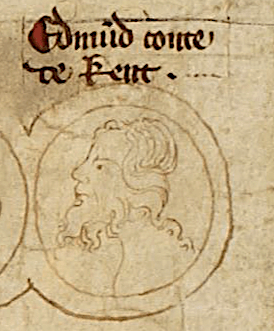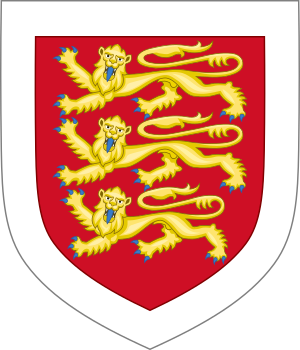Edmund of Woodstock, 1st Earl of Kent facts for kids
Quick facts for kids
Edmund of Woodstock
|
|
|---|---|
 |
|
| 1st Earl of Kent | |
| Tenure | 26 July 1321 – 19 March 1330 |
| Successor | Edmund, 2nd Earl of Kent |
| Known for | Younger half-brother of Edward II of England |
| Years active | 1318–1330 |
| Born | 5 August 1301 Woodstock, Oxfordshire |
| Died | 19 March 1330 (aged 28) Winchester Castle |
| Cause of death | Execution |
| Buried | Westminster Abbey 51°29′58″N 0°7′43″W / 51.49944°N 0.12861°W |
| Wars and battles | War of Saint-Sardos |
| Offices | Lord Warden of the Cinque Ports |
| Spouse(s) | Margaret Wake, 3rd Baroness Wake of Liddell |
| Issue | Edmund, 2nd Earl of Kent Margaret, Viscountess of Tartas Joan, 4th Countess of Kent, Princess of Wales John, 3rd Earl of Kent |
| Parents | Edward I of England Margaret of France |
Edmund of Woodstock, 1st Earl of Kent (born August 5, 1301 – died March 19, 1330) was an important figure in English history. He was the sixth son of King Edward I of England. His mother was Margaret of France, who was Edward I's second wife. This made Edmund the younger half-brother of King Edward II of England.
Edmund was given the title of Earl of Kent in 1321. He served his half-brother, King Edward II, as a diplomat and military leader. He helped the king put down a rebellion in 1321–1322. However, later on, Edmund joined a rebellion against Edward II. This rebellion was led by Queen Isabella and Roger Mortimer.
King Edward II was removed from power. But Edmund soon found himself disagreeing with the new leaders. In 1330, he was found to be involved in a new plan against the government. Because of this, he was put to death. Later, when the new king, Edward III, grew up, he cleared Edmund's name.
Contents
Who Was Edmund of Woodstock?
His Early Life and Family Connections
Edmund of Woodstock was born on August 5, 1301, in Woodstock, Oxfordshire. This is how he got the name "of Woodstock." His father was King Edward I of England. His mother was Margaret of France. She was the daughter of the French king, Philip III of France.
Edmund had an older half-brother, Edward II of England, who became king when Edmund was only five years old. King Edward I had planned to give Edmund a lot of land. But when Edward II became king, he gave some of that land to his favorite friend, Piers Gaveston. This upset Edmund and his older brother, Thomas.
Even so, Edward II made sure Edmund had an income. In 1315 and 1319, Edmund received money each year. He also gained control of Gloucester Castle in 1321. Soon after, on July 28, 1321, he was made the Earl of Kent.
Edmund's First Steps in Politics
As Edmund grew older, he became an important part of his brother King Edward II's court. In 1318, he helped sign the Treaty of Leake. This treaty was an effort to bring peace between the king and some powerful nobles.
Edmund also went on a special trip to see Pope John XXII in Avignon in 1320. Their goal was to get the Pope to free the king from a promise he made. This promise was about following certain rules set by the nobles. Later that year, Edmund joined his brother in France. There, Edward II showed respect to the French king for his lands in France.
Edmund's Role in Civil Unrest
Conflict with the Despensers
In 1321, a big conflict started in England. It was called the Despenser War. This was because many people were unhappy with the king's new favorites. These were Hugh Despenser the Younger and his father, Hugh Despenser the Elder.
Edmund first sided with the nobles who wanted the Despensers sent away. But he later said he was forced to do so. In November 1321, he joined the group that brought the Despensers back.
Edmund then helped the king fight against the rebels. He took part in attacking Leeds Castle in Kent. He also helped defeat Roger Mortimer and other rebels in Wales.
The Downfall of Thomas of Lancaster
Edmund was also involved in the capture of Thomas of Lancaster. Lancaster was a powerful noble who led the opposition to the king. Edmund helped take Lancaster's castle, Pontefract Castle.
After Lancaster was defeated in battle, he was brought to Pontefract. Edmund was part of the group that decided Lancaster's fate. Lancaster was found guilty of acting against the king and was put to death.
For his loyalty, Edmund received land in Wales. This land had belonged to Roger Mortimer. However, the Despensers received much more wealth and land than Edmund.
Challenges in Scotland and France
Defending the Northern Border
After the civil unrest, King Edward II focused on Scotland. In 1322, the English army was defeated by the Scots at the Battle of Old Byland. Edmund was with the king as they retreated.
Later, a commander named Andrew Harclay made a peace treaty with Scotland without the king's permission. Harclay was arrested, and Edmund was one of the judges who found him guilty. Harclay was put to death.
Edmund was then given the job of defending the northern border against Scotland. But the situation was very difficult. In 1323, Edmund was part of the group that agreed to a thirteen-year truce with Scotland.
War in Aquitaine
At the same time, England's lands in France were in danger. The French king, Charles IV of France, wanted Edward II to show respect for his French lands. There was also a local dispute that led to conflict.
In 1324, Edmund was sent to France to try and make peace. But the talks failed. Edmund was then made the leader of the English forces in Aquitaine. He needed more soldiers from England, but they never arrived.
In a short war called the War of Saint-Sardos, the French quickly took over English lands. Edmund was trapped in a town called La Réole. He held out for a while but was forced to surrender. He agreed to a six-month truce.
The End of Edward II's Reign
Joining the Rebellion
King Edward II sent his wife, Queen Isabella, to France to negotiate with her brother, the French king. In 1325, their son, Prince Edward, joined her.
Queen Isabella and Prince Edward did what was needed to make peace. Soon after, Edmund joined them in Paris. A group of people who opposed King Edward II gathered around the queen. This group included Roger Mortimer, who had been exiled.
Edmund, who had always been loyal to his half-brother, now joined this plan against the king. He did not trust Mortimer, but he disliked the Despensers even more. When Edmund and the others refused to return to England, their lands were taken away in March 1326.

In September 1326, Isabella and Mortimer invaded England with soldiers. Edmund was part of this invasion. Many English nobles supported them, including Edmund's brother Thomas.
Edmund took part in the trials of the Despensers. He also helped transfer power to Prince Edward, who became King Edward III. For his help, Edmund received land that had belonged to the Despensers.
Disagreement with the New Leaders
Edmund was given a role in defending the border with Scotland. But he soon became unhappy with the new government. He disliked how much power Roger Mortimer had at court.
In 1328, Edmund and his brother Thomas joined a plan against Isabella and Mortimer. But this plan failed, and the two brothers left the group.
Edmund's Final Years
A New Plot and His Death
After the failed plan, Edmund became less popular at court. He was still allowed to attend the coronation of the king's wife, Philippa, in 1330. But he appeared at court less often.
Around this time, Edmund became involved in another plot against the government. He was tricked into believing that his half-brother, Edward II, was still alive. It turned out that Roger Mortimer himself had spread these false rumors to trap Edmund.
The plot was discovered. In March 1330, Edmund was found guilty of acting against the king and was sentenced to death. It was hard to find anyone willing to carry out the sentence on a man of royal blood. Finally, a convicted person agreed to do it in exchange for a pardon.
Edmund was first buried in a church in Winchester. But in 1331, his body was moved to Westminster Abbey.
Aftermath and Legacy
Edmund's death was a big event for the young King Edward III. The king had not been involved in the decision. In October 1330, Edward III took full control of the government. Roger Mortimer was then put to death. One of the reasons given for Mortimer's death was that he had caused Edmund's death.
The charges against Edmund were removed. In 1325, Edmund had married Margaret Wake. They had several children. His oldest son, also named Edmund, inherited his lands and titles. But this Edmund died in 1331. The title then passed to his younger son, John.
Edmund was not always seen as a reliable person during his life. He often changed which side he supported in political issues. However, it is also noted that he showed great loyalty to Edward II, even when he did not receive many rewards from his brother.
Edmund's Children
| Name | Birth date | Death date | Notes |
|---|---|---|---|
| Edmund, 2nd Earl of Kent | 1326 | bef. 5 October 1331 | |
| Margaret of Kent | 1327 | 1352 | She was planned to marry Arnaud Amanieu, Lord of Albret, but the plans did not happen. |
| Joan of Kent | 28 September 1328 | 7 August 1385 | Known as "The Fair Maid of Kent". She married Thomas Holland, 1st Earl of Kent. Later, she married Edward, the Black Prince, who was the son of Edward III. |
| John, 3rd Earl of Kent | 7 April 1330 | 26 December 1352 |
See also
 In Spanish: Edmundo de Woodstock para niños
In Spanish: Edmundo de Woodstock para niños


